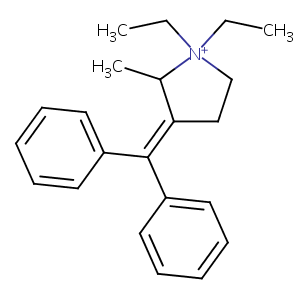Details of the Drug
General Information of Drug (ID: DMMZB0K)
| Drug Name |
Prifinium
|
|||||||||||||||||||
|---|---|---|---|---|---|---|---|---|---|---|---|---|---|---|---|---|---|---|---|---|
| Synonyms |
Prifinium; 10236-81-4; 3-(Benzhydrylidene)-1,1-diethyl-2-methylpyrrolidinium; Prifinum; NCGC00183859-01; EINECS 233-568-5; AC1Q1ITK; AC1L1J7T; SCHEMBL14672576; 3-benzhydrylidene-1,1-diethyl-2-methylpyrrolidin-1-ium; CHEMBL1229214; CTK4A0968; 3-Diphenylmethylene-1,1-diethyl-2-methylpyrrolidinium
|
|||||||||||||||||||
| Indication |
|
|||||||||||||||||||
| Drug Type |
Small molecular drug
|
|||||||||||||||||||
| Structure |
 |
|||||||||||||||||||
| 3D MOL | 2D MOL | |||||||||||||||||||
| #Ro5 Violations (Lipinski): 1 | Molecular Weight (mw) | 306.5 | ||||||||||||||||||
| Topological Polar Surface Area (xlogp) | 5.1 | |||||||||||||||||||
| Rotatable Bond Count (rotbonds) | 4 | |||||||||||||||||||
| Hydrogen Bond Donor Count (hbonddonor) | 0 | |||||||||||||||||||
| Hydrogen Bond Acceptor Count (hbondacc) | 0 | |||||||||||||||||||
| ADMET Property |
|
|||||||||||||||||||
| Chemical Identifiers |
|
|||||||||||||||||||
| Cross-matching ID | ||||||||||||||||||||
Molecular Interaction Atlas of This Drug
 Drug Therapeutic Target (DTT) |
|
||||||||||||||||||||||||||
|---|---|---|---|---|---|---|---|---|---|---|---|---|---|---|---|---|---|---|---|---|---|---|---|---|---|---|---|
| Molecular Interaction Atlas (MIA) | |||||||||||||||||||||||||||
References
